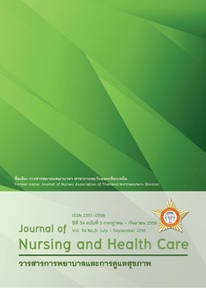ศักยภาพและรูปแบบการจัดการด้านความมั่นคงทางอาหารและอาหารปลอดภัยในชุมชน ตำบลควนรู อำเภอรัตภูมิ จังหวัดสงขลา Community Capacity and Food Security and Food Safety Management Model: A Case Study in Khuan Ru Sub-district, Rattaphum District, Songkhla Province
คำสำคัญ:
ศักยภาพ รูปแบบ การจัดการด้านความมั่นคงทางอาหารและอาหารปลอดภัย capacity, model, food security management, food safety management, communityบทคัดย่อ
บทคัดย่อ
การวิจัยเชิงคุณภาพ เพื่อศึกษาศักยภาพและรูปแบบการจัดการด้านความมั่นคงทางอาหารและอาหารปลอดภัยในชุมชน
ตำบลควนรู อำเภอรัตภูมิ จังหวัดสงขลา ผู้ให้ข้อมูลจำนวน 36 คน ผู้ให้ข้อมูลหลักถูกคัดเลือกแบบเจาะจงใน 4 องค์กรหลักคือ ผู้บริหารองค์กรปกครองส่วนท้องถิ่น หน่วยงานราชการ องค์กรท้องที่ และภาคประชาชน แกนนำแหล่งเรียนรู้ต่างๆเกี่ยวกับอาหาร เก็บรวบรวมข้อมูลโดยการสนทนากลุ่ม ร่วมกับการสัมภาษณ์เจาะลึก และการสังเกตแบบไม่มีส่วนร่วมในการทำกิจกรรมต่างๆ ของแหล่งเรียนรู้เหล่านั้น ใช้เทคนิคการตรวจสอบสามเส้า วิเคราะห์ข้อมูลเชิงเนื้อหา
ผลการวิจัย พบว่า 1) ศักยภาพของชุมชน เป็นทุนทางสังคมทั้งเชิงโครงสร้างและทุนเชิงกระบวนการเรียนรู้ ประกอบด้วย
ทุนคน ทุนด้านทรัพยากรธรรมชาติและแหล่งประโยชน์ในชุมชน ทุนเงิน และทุนองค์กร/หน่วยงาน/สถาบัน 2) รูปแบบการจัดการด้านความมั่นคงทางอาหาร ชุมชนมีระบบและกลไกขับเคลื่อนการทำงานผ่านระบบความมั่นคงทางอาหารและสัมมาชีพโดยมีรูปแบบการจัดการด้านต่างๆ คือ การจัดการงาน การจัดการคน การจัดการฐานทรัพยากร การจัดการภูมิปัญญา และการจัดการทุน และ 3) รูปแบบการจัดการด้านอาหารปลอดภัย ชุมชนมีระบบและกลไกขับเคลื่อนการทำงานผ่านระบบการดูแลสุขภาพในตำบล โดยมีทุนทางสังคมทั้งหน่วยงานราชการในพื้นที่และภาคประชาชนทำหน้าที่ ครอบคลุมตลอดห่วงโซ่อาหารตั้งแต่ต้นนํ้า กลางนํ้า และปลายนํ้า ดังนั้น ควรพัฒนาศักยภาพของทุนทางสังคม รวมทั้งผลักดันรูปแบบการจัดการด้านความมั่นคงทางอาหารและอาหารปลอดภัยให้คงอยู่และมีศักยภาพสูงขึ้นต่อไป
Abstract
This ethnographic research aimed to explore the community capacity and identify a model of food security and food safety management in Khuan Ru sub-district, Rattaphum district, Songkhla province. Sample consisted of 36 key informants, purposively selected from four groups of stakeholders including: 1) local administrative organization, 2) government agencies, 3) local organizations, and 4) public sectors (a group of food learning unit
leaders). Focus group technique and in-depth interview were applied for data collection. Non-participatory observations were also performed to observe activities in food learning units. Triangulation technique was used.Data were analyzed using content analysis.
Results revealed that the community capacity was a social capital in terms of structure and learning process including human capital, natural resources and community facilities, money, and organization/agency/institution in the community. There was a community-driven mechanism and system that were used to manage food security.There were various aspects of management including the management of work, human resource, resource base,
local wisdom, and capital management. The community’s management of food safety had system and the community-driven mechanism of working through health care system in the sub-district. The involved social capital were the local government agencies, the public sector as well as food chain from downstream, midstream,and upstream. Therefore, a capacity building of the social capital should be promoted and increased. Efforts should
be made to sustain high quality of food security and food safety management in the community.



